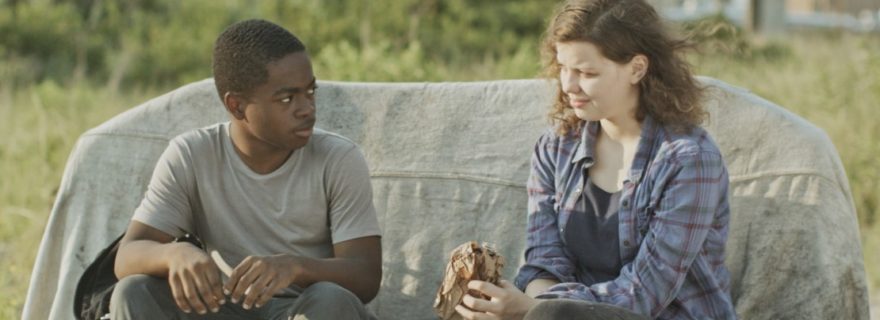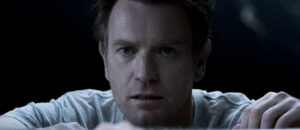'The Transfiguration'
Movie Rating:
3.5
Movie monsters tend to move in cycles. We just got out of a soapy vampire romance trend, so the time has come for the undead blood suckers to become moody and unsettling creatures again. First-time writer/director Michael O’Shea attempts to bring back the art house vampire flick with his eccentric debut that knocks down ‘Twilight’ and revives the tropes of the most underrated films in the vampire genre.
‘The Transfiguration’ so overtly revives the concept of George A Romero’s ‘Martin’ that accusations of plagiarism would be viable if not for the fact that O’Shea litters his film with references to many vampire films of the past. It’s clearly an act of homage and ‘Martin’ isn’t the only focus of the homage-athon.
Eric Ruffin stars as Milo, a disenfranchised teen dodging drug dealers and family tragedy in a New York housing project. The character is utterly alone and alienated from the world, finding solace, like so many outcasts, in horror movies (a genre filled with outcast monster metaphors). He’s specifically obsessed with vampires, taking meticulous notes documenting which vampire films are the most realistic. The reason he narrows in on realism for his vampire judgment? Because the kid thinks he’s a vampire, of course, even hunting for blood in sequences that we’re never quite sure are real. Milo lives a dark and isolated life, but a little hope slips in once he meets an equally dejected teen, Sophie (Chloe Levine). Slowly, the pair bond and even tiptoe toward love. There’s a chance it could be enough to save Milo from his unfortunate existence, were it not for that whole vampire thing.
The debut feature feels highly personal for Michael O’Shea. This is twofold. First, it’s the work of an unabashed horror fan, flaunting his credentials. The characters discuss ‘Let the Right One In’, ‘Twilight’, ‘Near Dark’, and watch ‘Nosferatu’ and ‘Faces of Death’. The filmmaker is openly drawing possibly unflattering comparisons to his own work, while also tipping the hat to his influences. That’s a dangerous game to play, and could easily make viewers long for other, better movies that they aren’t watching.
Thankfully, that doesn’t happen. The other personal aspect of ‘The Transfiguration’ is the sense of teenage desolation and urban isolation. The mood of the film is palpable. You may not be able to identify with the vampire-influenced-murder-spree thing, but the pain and loneliness are universal. The performances (especially from Ruffin and Levine) are heartbreakingly naturalistic. The film works as straight drama, with the pain vividly coming through between the horror set-pieces and discussion. O’Shea captures very teenage versions of emotions and confusions. He’s just done it with some murders tossed in for good measure.
The vampire sequences are executed with a sense of grim ambiguity. They’re harsh and violent, but always done in the film’s sense of slightly detached realism. They bite (bad bun alert!) hard, but are delivered in such a way that they could easily be written off as fantasy. Part of that is due to the intriguing style that O’Shea uses to mount his film. Handheld cameras follow Milo with almost uncomfortable intimacy. Decaying New York streets create an environment of dread, isolation, and loss without the filmmaker ever overtly stating those themes. The movie has a woozy sense of horror. It’s not garishly stylized or executed with conventional suspense/horror grammar. The film feels like a delicate indie character piece with horror woven into it.
It certainly doesn’t hurt that O’Shea shot on the streets of New York with a small crew and extras who were unaware that they were taking part in a feature film. The world feels grounded, real, and lived-in because everything in the frames was found on the streets. When the horror sequences kick in, they operate on a mixture of grounded grit and disorienting fantasy, further blurring the line of reality. ‘The Transfiguration’ feels like both docudrama and a subjective journey into the protagonist’s fractured mental state without one overwhelming the other. It’s for the audience to decide the balance.
Of course, as impressive as all that style and substance can be, there’s no ignoring how much was taken wholesale from ‘Martin’. Even though this is an update with its own identity, location and sense of character, in a movie that constantly makes you consider other movies, it’s nearly impossible to ignore the elephant in the room. O’Shea is playing on hallowed ground for the particular strain of cult horror audiences that he craves. How they react will be entirely subjective. For me, it feels like a promising debut filled with reference, homage, and theft to all of O’Shea’s filmmaking influences, which inches out enough of its own voice to avoid redundancy. Others may disagree and it won’t be until the filmmaker follows up this feature with a sophomore effort that we’ll know the truth. For now, ‘The Transfiguration’ remains a promising genre oddity and one of the most intriguing vampire flicks in years.



